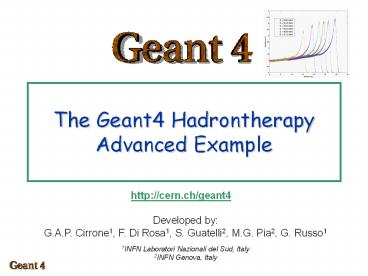The Geant4 Hadrontherapy Advanced Example PowerPoint PPT Presentation
Title: The Geant4 Hadrontherapy Advanced Example
1
The Geant4 Hadrontherapy Advanced Example
- http//cern.ch/geant4
Developed by G.A.P. Cirrone1, F. Di Rosa1, S.
Guatelli2, M.G. Pia2, G. Russo1 1INFN Laboratori
Nazionali del Sud, Italy 2INFN Genova, Italy
2
Contents
- User requirements
- Design of the physics component
- Implementation
- Geometry component
- Primary particle component
- Physics component
- Calculation of the energy deposit
- Analysis component
- How to execute the Hadrontherapy advanced example
3
User requirements
4
User requirements
- The user shall be able to
- Model a hadrontherapy beam line in terms of
- Geometry components
- Proton beam
- Model a phantom as a water box
- Model the electromagnetic and hadronic
interactions - Choose alternative approaches interactively to
model - Electromagnetic interactions
- Hadronic interactions
- Calculate the energy deposit in the phantom
derived from - Both primary (the incident proton beam) and
secondary particles - Store the results of the simulation
- 3D energy deposit in the phantom
- Bragg peak
- Etc.
- in histograms and n-tuples
- Visualise the experimental set-up and the tracks
of the particles
Experimental set-up
Physics
Results of the simulation
Visualisation
5
Design of the physics component
Particles
Messenger
Alternative approaches to model p, n, pions
hadronic interactions
Modularised physics component The user can
configure the simulation with different physics
options transparently
Alternative approaches to model protons, ions,
e-, photons, e EM interactions
6
Implementation
7
Implementation
- Hadrontherapy example
- header files in include/.hh, source code in src/
.cc - main in Hadrontherapy.cc
- macro defaultMacro.mac
- Classes
- HadrontherapyAnalysisManager
- HadrontherapyDetectorConstruction
- HadrontherapyDetectorMessenger
- HadrontherapyMaterial
- HadrontherapyPrimaryGeneratorAction
- HadrontherapyPhysicsList
- HadrontherapyPhysicsListMessenger
8
Detector Component
- The proton beam line is modelled in the
experimental set-up in terms of - Geometrical components
- Materials
Geant4 simulation
9
Primary particle component
Mean value Sigma
Energy 63.5 MeV 400. keV
Position (x0, 0, 0) (0., 1., 1.) mm
Direction (1., 0., 0.) (0., 0.0001, 0.0001)
- The primary particles are protons
Origin of the primary particles
X axis
10
Physics component
Hadronic
Electromagnetic
- Parameterized (à la GHEISHA)
- Nuclear Deexcitation
- Default evaporation
- GEM evaporation
- Fermi break-up
- Pre-equilibrium
- Precompound model
- Bertini model
- Intra-nuclear cascade
- Bertini cascade
- Binary cascade
- Elastic scattering
- Parameterized
- Bertini
- For protons and ions
- Standard
- Low Energy ICRU 49
- Low Energy Ziegler 1977
- Low Energy Ziegler 1985
- Low Energy Ziegler 2000
- For electrons and photons
- Standard
- Low Energy Livermore
- Low Energy Penelope
- For positrons
- Standard
- Low Energy - Penelope
11
Phantom
- The phantom is set in front the beam line
X axis
- The phantom is subdivided in 200 voxels along
x, y, z axis - The energy deposit is calculated in the voxels
- The result of the simulation is
- 3D energy deposit in the phantom
- Energy deposit with respect to the depth in the
phantom along the x axis
12
Analysis component
- AIDA 3.2.1 and PI 1.3.8
- The simulation produces a .hbk file at the end
- hadrontherapy.hbk
- The Bragg peak is saved in a 1D histogram (ID
10) - The 3D energy deposit in the phantom is stored in
a ntuple
3 109 events
13
Control, monitor the simulation
14
Messengers
- Interactive commands are defined
- to select
- Physics processes
- Physics models
- To model electromagnetic and hadronic
interactions of particles - to change
- Geometrical parameters of the proton beam line
- Energy, position and direction of the primary
particles
15
How to select the physics models
- Example of macro
- /control/verbose 1
- ..
- /physics/addPhysics photon-epdl
- /physics/addPhysics electron-eedl
- /physics/addPhysics positron-standard
- /physics/addPhysics ion-LowE
- /physics/addPhysics muon-standard
- /physics/addPhysics decay
- /physics/addPhysics proton-precompound
- /run/initialize
- ..
- /run/beamOn 100
16
How to run
- Define necessary environment variables
- source
- How to compile and link
- gmake
- How to run
- G4WORKDIR/bin/Linux/Hadrontherapy
- (defaultmacro.mac is executed by default)
- Result of the simulation hadrontherapy.hbk
17
Comments on the Geant4 physics
- Wide set of physics processes and models offered
by Geant4 - The Hadrontherapy advanced example provides
examples of physics lists - How to best choose the most appropriate model for
a particular experimental set-up? - The user has to select the physics models
- Electromagnetic and hadronic components
- The user has to validate his/her Geant4 physics
component with respect to reference data
A comprehensive assessment of Geant4
electromagnetic physics with respect to
established reference data is documented in
K. Amako et al., Comparison of Geant4
electromagnetic physics models against the NIST
reference dataIEEE Trans. Nucl. Sci., Vol. 52,
Issue 4, Aug. 2005, pp. 910-918

